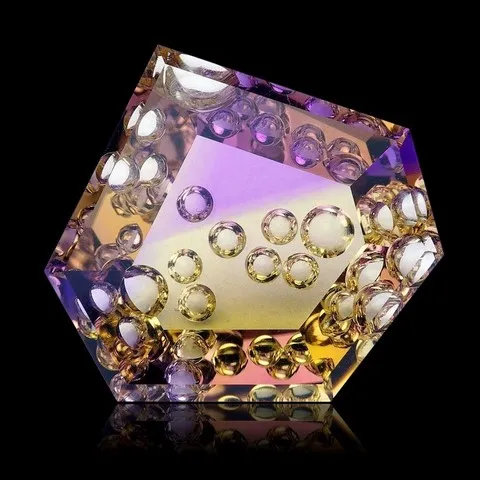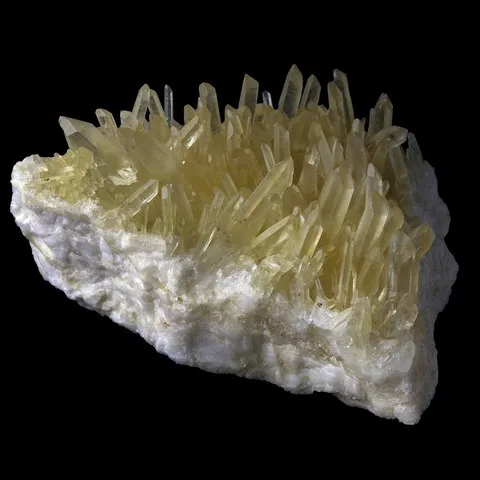CITRINE
Class : Silicate
Subclass : Tectosilicate
Crystal system : Trigonal
Chemistry : SiO2
Rarity : Very rare
Citrine is a yellow-orange variety of quartz. Its name comes from the Latin citrus (lemon) in reference to its color which is due to the presence of traces of iron oxide in the crystal lattice of quartz. Natural, untreated citrine is the rarest of the quartz varieties. Its crystals are almost non-existent, and its rough materials come mainly from the yellow parts of ametrines. Very many crystals sold under the name "citrine" are generally smoky quartz whose color tends to yellow (due to a slight natural irradiation) or else quartz having a coating of iron oxides on the surface and which has a slight yellowish tint. Citrine is widely used as a gemstone, like many other varieties of quartz. Genuine citrine (natural and untreated) remains however a very rare variety, almost all specimens on the market are fake citrines, obtained by various processes mentioned below.
Citrine in the World
Citrine in France
Citrine is not present in the French underground, even if some quartz can take on yellowish tints, this is due to the presence of iron oxide on the surface.
Twinning
The amethyst crystals twin in the same way as quartz, all quartz crystals are usually twinned, and there are more than 20 different twins for this species. The twins of quartz are, however, difficult to spot. The most obvious is called "La Gardette" or "Japan" twin law. The "La Gardette" twins is formed of two individual crystals whose axis is at an angle of 84.33 °. The ametrine crystals are almost all in twin from Brazil, as for quartz. This twin is however undetectable without a polarizing filter.
Inks and surface treatments
Among the classic scams we note the natural quartz geodes painted in yellow or orange. The yellow-orange inks used generally do not hold, a passage in water or in acetone is enough to reveal the deception... These items are generally sold at low prices.
More vicious and produced in China, groups of colorless natural quartz are commonly covered with a thin yellow layer by metallization process (same treatment process as for obtaining blue crystals called "aqua aura"). The crystals are placed under vacuum, and an electric current of high intensity and low voltage is sent through a metallic filament which heats up and sublimates the metal which composes it. The metal in the form of vapor will then be deposited on the surface of the crystals and can then be removed only by mechanical means. The metallization color obtained depends on the nature of the filament used (titanium or gold for aqua aura blue quartz). It is also possible to color quartz in yellow by chemical precipitation.
Synthetic citrines
More subtle and much rarer on the market, we can find synthetic citrines. Quartz is conventionally synthesized in devices called "autoclaves", kinds of pressure cookers which make it possible to increase the pressure and temperature of a chemical solution. These "hydrothermal" quartzes as we call them have a tabular facies, they do not look anything like natural quartz. They are not twinned in order to present optimal piezoelectric characteristics for electronics, the main consumer sector of synthetic quartz. Some may have ended up on the gem market in particular. The major problem is that a small quantity of naturally occurring pyramidal facies citrine specimens has managed to be produced in China by this method and put on the market. These citrines are floaters whose matrix is a piece of granite, the crystals are zoned and can sometimes lightly turn purple, amethysts have also succeeded in being produced by this same process. The photo on the left shows a synthetic specimen sold on eBay for natural...
Citrine treatments
Most of the citrine in the market comes from heated amethyst. Indeed, when the amethyst is brought above 500°C, a yellow-orange color is obtained which can sometimes be bright (main photo). The problem with this treatment is that it cracks the crystals that contain too many fluid inclusions, often making them crumbly and brittle.
Another treatment has appeared on the market since the 2010's to produce the famous color yellow. It consists of the irradiation then the successive heating of colorless and transparent quartz. This process produces a natural, non-garish yellow that closely resembles the yellow of natural, untreated citrine parts of ametrine. The specimens are available in natural crystals, polished prisms, eggs, spheres, sculptures, tumbled stones (photo on the right), etc...
Hardness : 7
Density : 2,65
Fracture : Conchoidale
Streak : White
TP : Transparent to opaque
RI : 1,544 to 1,553
Birefringence : 0,009
Optical character : Uniaxial +
Pleochroism : Weak
Fluorescence : Très rare
Solubility : Hydrofluoric acid
Magnetism : None
Radioactivity : None








